i’m really not a nostalgic person at all, but it recently occurred to me that when i created the first 5:4 Best Albums of the Year list, my reason for choosing to include 40 entries was due to the oh-so-many years as a teenager that i’d spent listening to the Top 40 on the radio each Sunday afternoon. For me, music charts are pretty much synonymous with the number 40, though for the last few years, i’ve been pondering the pros and cons of that association. i’ve previously discussed the dual definitive / provisional nature of these lists, and many of you will be aware that i therefore update my annual Best Albums lists periodically (usually a couple of times each year), a process where the lower ends of the lists experience considerable change, while the upper ends remain more or less consistent. This year i’ve been questioning the number 40 more than ever, and i’ve decided to up the ante and slightly reduce my Best Albums list to 30 entries, thereby representing a more exclusive, higher quality selection that will testify more authentically – and, going forward, more consistently – to what’s really the best of the year.
So: here’s the first half of this year’s list (for a reminder of the rules and process behind the list, go here). 2021 has been just as difficult, if not more so, than 2020, but these albums have all provided vital solace, consolation, uplift and above all wonderment. In uniquely different ways, each of these albums makes life significantly better.
30 | Natasha Barrett – Leap Seconds

“Her use of extant sounds is often abstracted to the point that our understanding of them as originating in real-world objects and phenomena is reduced to mere gestural associations: a hard impact, a rush of noise, sounds that may have begun as wood and air but may just as easily have been constructed from scratch in the computer. This becomes complicated when Barrett, as she equally often does, uses both of these sounds within soundworlds that either directly evoke or reflect upon real-world situations and contexts. However, she also doesn’t shy away from incorporating portions of field recording that, in this context, appear almost shockingly untouched and immediately identifiable. […] Not so much a liminal as a polarised music. […] What’s especially beguiling about Involuntary Expression is its mesmeric yet elusive duality: always compelling, always out of reach; unfathomable but, somehow, understandable. In conjunction with the fascinating forms of polarised materials used to fashion these very different pieces, they make Leap Seconds a superb testament to Natasha Barrett’s uniquely fantastical musical language, glorious sonic paradoxes rooted in the world and the imagination, redolent of everywhere and nowhere.” [reviewed in May]
29 | Beth McDonald – Densing
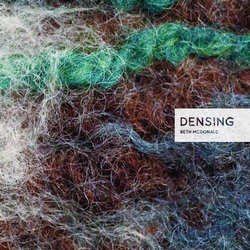
Beth McDonald describes herself as “a classically trained tuba player gone awry”, which gives some idea of the kind of thing she gets up to on her latest album, Densing. All five pieces on the album are improvisations mixing tuba and electronics, taking their name from days of the week. Some of them display a more passive approach, such as ‘Sunday’, in which McDonald transforms her instrument into a gaseous form, progressing as a deep ambient drift, dronal and throbbing. ‘Tuesday (other)’ is pared back even further, undergoing a slow buzzy oscillation around two chords. But sparse and / or remote details are a feature throughout the album as a whole, even when McDonald is more demonstrative. ‘Tuesday’ is a study in intense juddering with small possibly melodic ideas moving behind or within, while ‘Saturday’ is like a chorus of artistic foghorns dolefully singing out in a dark, dense space. The highlight of the album, though, is ‘Thursday’, where the tuba becomes something akin to a far-off organ, almost conveying a hauntological sense in the way weak but tangible details leak and bleed through its otherwise clouded exterior. [CD/DL]
28 | Berglind María Tómasdóttir – Ethereality

“Stomachs of Ravens by … Carolyn Chen … acts as something of an overture, developing from a mixture of tiny gestures and slapped notes into a more full-bodied melody. […] Berglind María Tómasdóttir‘s own work Bambaló continues this melodic strain but with a greater sense of intimacy, lacking any reverb, focusing in on the flute in a way that’s more expansive yet internalised. […] The tone abruptly changes with Lilja María Ásmundsdóttir‘s og brenna eins og fuglinn inn í eilífðina…: an immediate electronic presence heard in a low rumble and a collection of hard-to-discern (possibly animal) sounds. These form the backdrop to a moody flute part that’s if anything more elusive than in Bambaló, making tentative intrusions into this passive ambient space. […] Shut Open by Clint McCallum is a complex, completely immersive soundscape that from the outset encloses us in a warm, viscous, gently pulsating environment. Somewhere within this are traces of flute, sometimes so far off it’s little more than an allusive whiff, other times practically next to us though, even here, laden with timbral ambiguities, obscuring its identity. It’s a gorgeous conclusion to a compelling 54-minute cycle that veers between extremes of scope and poles of acoustic and electronic emphasis.” [reviewed in October]
27 | various artists – New Estonian Choral Music
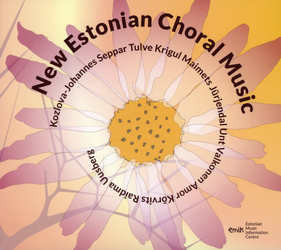
One of three new discs showcasing Estonian music (which i’ll be exploring in more depth in the new year), this album is further proof that the country’s choral music, and their choirs, are among the very best in the world. It features a number of superlative works – Tatjana Kozlova-Johannes’ To My End and To Its End, Evelin Seppar’s Seesama meri and Helena Tulve’s You and I – all of which i’ve written about previously and still cannot praise highly enough. Additional highlights include Gerta Raidma’s ja me oleme valgusest tehtud (and we are made of light), an exquisite essay in discreet transcendence that both confronts and embraces death and rebirth, and Et kiitke jumalat, kes on nii helde (Praise god, ye people, for he is generous) by Estonia’s answer to John Rutter, Pärt Uusberg, thankfully showing here that not everything he does needs to be laden with either sugar or cheese. Perhaps the disc’s most intriguing wonder is Vesi ise (Water is) by Ülo Krigul, a work for choir and tape setting sound poetry, suffused with a genuinely strange form of chiaroscuro, and demonstrating an altogether more radical conception of choral writing. [CD]
26 | Sleigh Bells – Texis

Following an unexpected lyrical turn in their last album Kid Kruschev, Sleigh Bells’ latest, Texis, picks up pretty much where 2016’s Jessica Rabbit left off. The schizoid volte-faces that characterised individual tracks on that album have here evolved into more cohesive, even elegant, twists and alternations. Take ‘An Acre Lost’, where the static, intimate focus of the verses is suddenly expanded in the broad scope and roaming harmony of the chorus. Their aggressive noise pop edge is often softened in order to articulate a no less heartfelt but more overtly lyrical and plaintive sensibility. ‘Knowing’ is an excellent example of this, a burst of punchy melancholia lamenting how “She finds herself awake in the dark / With the same old shit screaming in her ears”. In ‘True Seekers’ the balance is even more sharply contrasting, establishing a driving, euphoric courage at a difficult prospect: “This is gonna hurt, but it’s worth it … / Strip away armor, strip away fear”. The way Sleigh Bells take the painful challenge in these and similar sentiments and express them with such buoyancy is remarkable and surprisingly inspiring. [CD/Vinyl/Digital]
25 | David Dunn – Verdant
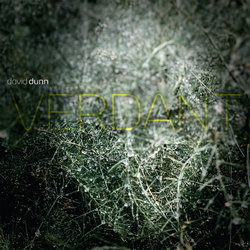
“It’s rare these days to find new additions to the sphere of ambient music that go beyond being merely extended, superficial, one-dimensional platitudes. So it’s been a relief to spend a mixture of active and passive time with Verdant … which taps into the heart of what makes ambient tick, presenting a fresh take on familiar techniques. […] Verdant effectively consists of a number of superimposed layers, some inhabited by a variety of bird sounds, songs and calls, others featuring pitched tones with different but essentially quite rudimentary electronic timbres… . The bird sounds are sporadic and vary considerably over time, sometimes occupying the foreground, other times more distant and for some stretches apparently dropping out entirely… . In this respect it’s easy to believe they derive from the natural presence and absence that a long field recording would yield. The electronic tones are more omnipresent, bleeping quietly in pretty, consonant fashion… . […] It’s really quite beautiful, and over the course of its 79-minute duration i’ve found myself drifting in and out of focus, making for an ideal balance of ignorability and interest.” [reviewed in May]
24 | Enno Poppe – Filz
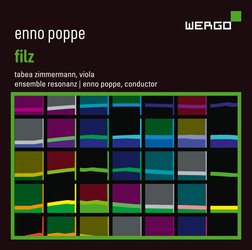
“It’s ironic that, of the three works on the disc, the one that exemplifies this best is also the least engaging. Composed in 2010, Wald utilises four string quartets in such a way that they continually slip between small- and larger-scale focus. […] Nonetheless, at its best the effect is potent, particular at points where generalised and specific actions occur simultaneously, such as around the centre of the piece, when tendrils start to extrude from the texture. Stoff, for nine string players, works better, primarily because it expands beyond an emphasis on behaviour to encompass a fascinating development of its ideas. Throughout the piece it’s hard to say to what extent what the players are doing is part of a unified action, a demonstration of cause and effect, examples of imitation (though who’s imitating whom?), or simply serendipitous (or perhaps even imagined) coincidences. […] The best example of interplay between individuals and groups, not surprisingly, comes in Poppe’s viola concerto Filz … . Here, the relationship between individual paths and progressions and group dynamics are at their most variegated and beautiful, forming exquisite textures filled with falling motifs like a chorus of sighs from which tiny morsels of pitch feel their way outward and upward.” [reviewed in June]
23 | Lux N:M – Dark Lux
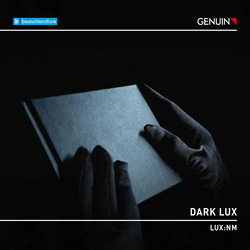
“A self-described “journey into the depths of the human soul” in order to “search for traces of evil, of nastiness and unpleasantness in everyday life”, the album primarily focuses on instrumental works by Gordon Kampe, alongside sound art by Jan Brauer and arrangements of music by Rameau and Gesualdo. Yet to think of Dark Lux in those terms – as a compilation of assorted, discrete pieces, and / or as an album made up 22 separate tracks – would be to miss the point of it as a single, large-scale experience encompassing nightmare, fever dream and hallucination. Heard in this larger context, its wild episodic shifts, with concomitant lurches of style, become interconnected scenes of a demented but cohesive drama, one that entirely lives up to the title, simultaneously dark and light. […] Moments of lyricism pop up along the way, though their softness is either challenged with sharp timbres and grotesque harmonies, through being channelled into a kind of black cabaret, or by manifesting as oblique folk songs and lullabies, rendered unsettling, even sinister, in this environment, as if their accompaniments were poised to swamp and destroy them. […] the result is enormously entertaining, a whirlwind of breathless, barbed high jinks that, after they’ve finally subsided, stay with you, playing on the mind and causing vestigial tingles to run down the spine.” [reviewed in July]
22 | various artists – The Brandenburg Project
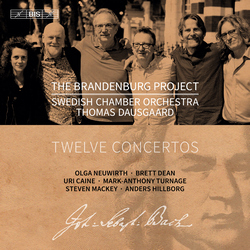
“Where some of the composers keep their distance from the Bach, Hillborg embraces it, first through glistening half-glimpses (which cause a frantic reaction) before indulging in quasi-direct quotations. The way these veer off is nicely spunky and irreverent, encroaching on jazz – walking bass and scat(!) – while, later, taking it into more remote territory, evoking Hillborg’s earlier work exploring vast, textural landscapes. In the [Olga] Neuwirth, everything sounds fundamentally connected to Brandenburg 4 but hugely distorted, elaborated, extended, embellished and otherwise (man)handled and (mis)treated. Neuwirth’s trusty typewriter … makes its presence felt here, and in the midst of such mayhem Aello‘s switch to ethereality in the central movement – filled with shimmering, floating notes – is unexpectedly and stunningly beautiful. With Hamsa, [Uri] Caine has created one of most insanely jubilant compositions i’ve ever heard, and also one of the most downright bonkers. More than any of the other composers, Caine stares at Bach in the face, always directly and emphatically responding to his material … . Its madness is utterly infectious, always remaining accessible despite being such a strange melée of wonders, somehow melding Hamsa into a just-about-coherent whole. It really needs to be heard to be believed.” [reviewed in June]
21 | Xiaogang Ye – Winter

“The highlights on this disc are also the two earliest works … : the violin concerto The Brilliance of Western Liang, dating from 1983, and the orchestral work Winter, from 1988. Both pieces exploit such extreme forms of equilibrium – contrasting materials pushed to the limit in terms of polarisation – that were it not for an inherently organic sensibility their respective narratives would tip over into pure melodrama. In the case of the concerto, Ye initially makes it sound so conventionally (neo-)romantic that when a huge, highly cinematic tutti suddenly erupts it’s as if nothing whatsoever makes sense anymore – where the hell did that come from? […] i can’t quite decide whether, in Winter, Ye reigns things in a bit, or pushes them still further. There’s less sense of immensity, though the contrast between the work’s languid, even sluggish material and its various climaxes – detonations of varying yield, and a remarkable explosion of counterpoint like a dawn chorus starting up all at once – is enormous, among the most dramatically arresting (apparent) non-sequiturs you’re ever likely to hear.” [reviewed in August]
20 | Rachika Nayar – Our Hands Against The Dusk

Rachika Nayar’s debut release is a delicately crafted survey of stability and disruption. A recurring idea is that of time slowed in a crude, almost pixelated way, resulting in sounds and ideas (often originating from a guitar) progressing as stuttering, repeating lurches. Though hard-edged, Nayar places these sounds within broader textural environments where harmonies – possibly emanating from, certainly sympathetic to, the same jittering source – slowly flow, and where traces of vocality appear like echoes and afterthoughts soaring on the wind. There’s a clear sense of discrete elements at play in these pieces, though while their tendency is to work in parallel, sometimes Nayar makes them more interactive. In ‘A Burning Plain’ she sets up a gentle but throbbing reverberant loop which is challenged by a secondary noise layer, initially creating an uneasy equilibrium but soon causing the noise to clip (in every sense) the edges of the guitar. ‘Aurobindo’ is more structurally and dramatically ambitious, moving back and forth between episodes of vagueness and clarity, the former heard as dense low registers with high undulating vocalise, the latter in deep pulsing bass tones that for a time bring order and solidity. Even in brief tracks like ‘Marigolds & Tulsi’ and ‘A Burning Plain’, Nayar’s music displays a beauty that’s simple but refined, and at times completely stunning. [DL]
19 | Sóley – Mother Melancholia
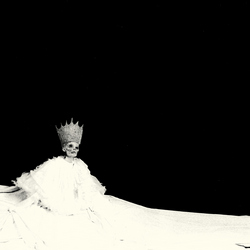
i’m still not entirely sure what to make of Mother Melancholia, which probably accounts for the fact i must have listened to it more than any other album in this year’s list. Though it’s not necessarily obvious at first, what Sóley has created is something grand – with more than a few hints of guignol – that gets under your skin without you realising it. The music walks a fine line between fragile intimacy and blazing passion, transitioning between these poles in such a way as to make them sound yet more extreme. Opening the album with ‘Sunrise Skulls’ is a bold move, though its trudging tone of pained resignation (suggesting sunset, if anything) is answered by a soft burn of hope: “The life has just began / Never give up”. This tilting between emotions characterises the album, though darkness and discomfort are etched everywhere. In equally outstanding tracks like ‘Blows Up’, ‘Parasite’ and ‘xxx’, Sóley conjures up a fin de siècle, vaguely apocalyptic landscape that veers between numb suspension and the looming threat of being swallowed up at any moment. Words are used sparingly, often abandoned in favour of abstract ruminations and laments that indicate all too clearly the tacit agony at the music’s heart. [Vinyl/DL]
18 | Wolfgang Mitterer – Temp Tracks

“Temp Tracks consists of 37 miniature compositions – ranging from a mere 31 seconds to nearly 4½ minutes – each of which functions as the soundtrack to a similarly small-scale imaginary movie scene. […] A recurring characteristic of many of the tracks is the apparent coexistence of two or more discrete layers of musical thought, existing in parallel such that the extent to which they affect or even impinge on each other can often be regarded as either negligible or entirely moot. This manifests most demonstratively in the juxtaposition of a kind of floating ‘underlay’ that progresses and develops in its own way and at its own pace while sporadic loud stings unpredictably fire out like futuristic cannon fire. […] it is a hugely discombobulating experience, though the growing familiarity – in terms of its scale, dramatic sense and musical / gestural vocabulary – works to unify the album as a whole and make it function as a large-scale iteration of what each track is doing in miniature. Heard in this way, Temp Tracks comes to resemble a bizarre 55-minute experimental movie constructed from 37 disparate yet related scenes that propel us pell-mell through heightened notions of tension and repose.” [reviewed in November]
17 | Ryoji Ikeda – Music for Installations Vol. 1
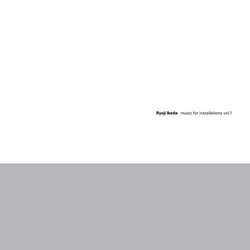
On the one hand, you always know what you’re getting with Ryoji Ikeda. On the other hand, his unique exploration of the world of data seems to show no signs whatever of exhaustion, if anything becoming ever more pertinent and personal with each passing year. He’s at his most dazzlingly impressive in his multimedia work, yet while the seven tracks on this album all originate in installation pieces, it’s surprising how much is retained when experienced without the visual component. The four ‘data’ pieces – all component modules from Ikeda’s huge datamatics project – provide alternate, parallel presentations of ways in which we understand and represent ourselves and our universe. One becomes acutely aware here of the extent to which Ikeda’s music embodies the same enormous sense of scope as displayed on screen, each track a deep, vivid dive into a space encompassing endless infinitude down to the most infinitesimal particles. In Ryoji Ikeda’s hands, everything becomes significant, rendered as a multiplicity of stylistic inflections in one of his most well-known works, ‘Test Pattern’. This is quintessential Ikeda, music fashioned from the most raw building blocks of electronic sound. [CD/DL]
16 | Danz CM – The Absurdity of Human Existence

Last year was a turning point in Danielle Johnson’s slow-burn, decade long career, that she described as outgrowing “the shy bedroom pop girl”. It’s clear from this album that she’s reached a new level of musical maturity. An especially arresting aspect of these songs is the way Johnson moves beyond her usual cool dispassion, addressing the foibles of life and relationships with increasing signs of emotional weight. ‘Breaking Point’ demonstrates this strongly, initially sung steadily on a single note (“I don’t want to reach / My breaking point”), before soaring out: “I don’t wanna break / But I don’t know / How much more” – the words poignantly breaking off, subsequently transforming the tone of the rest of the song. There’s a beautifully intimate euphoria in ‘Don’t Stop’, focusing the joys of a “fatal attraction” in its quietly glorious refrain, “Don’t stop make me feel high / Don’t stop it just feels right / Dangerous you blow my fucking mind”. But she’s at her most emotionally potent in final track ‘Human Existence’, a tiny pop elegy to the isolating enormity of life and the fact that “People go as fast as they / Come into this world”, imploring “Hold me closely while we go it alone”. [Vinyl/CD/DL]

[…] increasingly sophisticated over the years, featuring in my Best Albums of the Year in 2018 and 2021 – but her most recent release is the score to a short film titled While Mortals Sleep, which […]
[…] only one of the three to not have any weak points at all, one of the reasons i included it in my Best Albums of 2021 list. As i mentioned there, quite apart from the fact that the country’s contemporary choral music […]